Abstract
Milrinone is a potent positive inotropic and vascular smooth muscle-relaxing agent in vitro, and therefore, it is not known to what extent each of these actions contributes to the drug's hemodynamic effects in patients with heart failure. In 11 patients with New York Heart Association class III or IV congestive heart failure, incremental intravenous doses of milrinone were administered to determine the dose-response relationships for heart rate, systemic vascular resistance, and inotropic state, the latter measured by peak positive left ventricular derivative of pressure with respect to time (dP/dt). To clarify further the role of a positive inotropic action, the relative effects of milrinone and nitroprusside on left ventricular stroke work and dP/dt were compared in each patient at doses matched to cause equivalent reductions in mean arterial pressure or systemic vascular resistance, indices of left ventricular afterload. Milrinone caused heart rate, stroke volume, and dP/dt to increase, and systemic vascular resistance to decrease in a concentration-related manner. At the two lowest milrinone doses resulting in serum concentrations of 63 +/- 4 and 156 +/- 5 ng/ml, respectively, milrinone caused significant increases in stroke volume and dP/dt, but no changes in systemic vascular resistance or heart rate. At the maximum milrinone dose administered (mean serum concentration, 427 +/- 11 ng/ml), heart rate increased from 92 +/- 4 to 99 +/- 4 bpm (P less than 0.01), mean aortic pressure fell from 82 +/- 3 to 71 +/- 3 mmHg (P less than 0.01), right atrial pressure fell from 15 +/- 2 to 7 +/- 1 mmHg (P less than 0.005), left ventricular end-diastolic pressure fell from 26 +/- 3 to 18 +/- 3 (P less than 0.005), stroke volume index increased from 20 +/- 2 to 30 +/- 2 ml/m2 (P less than 0.005), stroke work index increased from 14 +/- 2 to 21 +/- 2 g X m/m2 (P less than 0.01), and dP/dt increased from 858 +/- 54 to 1,130 +/- 108 mmHg/s (P less than 0.005). When compared with nitroprusside for a matched reduction in mean aortic pressure or systemic vascular resistance, milrinone caused a significantly greater increase in stroke work index at the same or lower left ventricular end-diastolic pressure. Milrinone caused a concentration-related increase in dP/dt (32% increase at maximum milrinone dose), whereas nitroprusside had no effect. These data in patients with severe heart failure indicate that in addition to a vasodilating effect, milrinone exerts a concentration-related positive inotropic action that contributes significantly to the drug's overall hemodynamic effects. The positive inotropic action occurs at drug levels that do not exert significant chronotropic or vasodilator effects.
Full text
PDF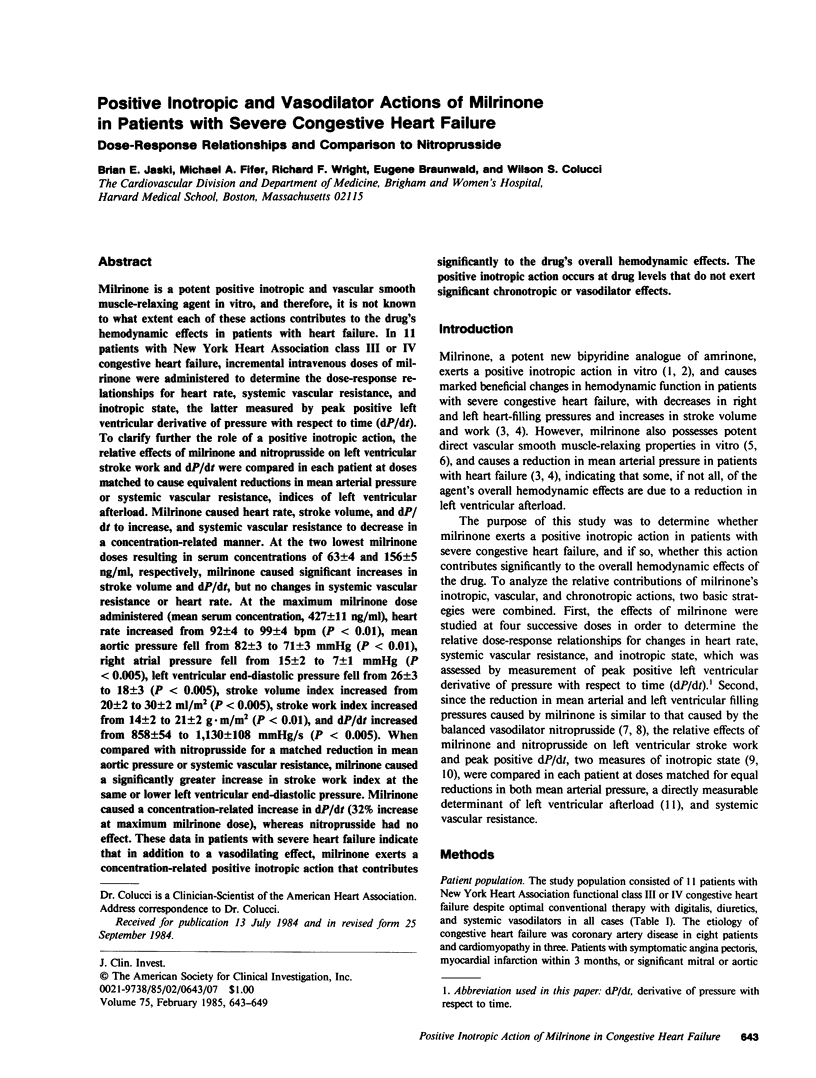
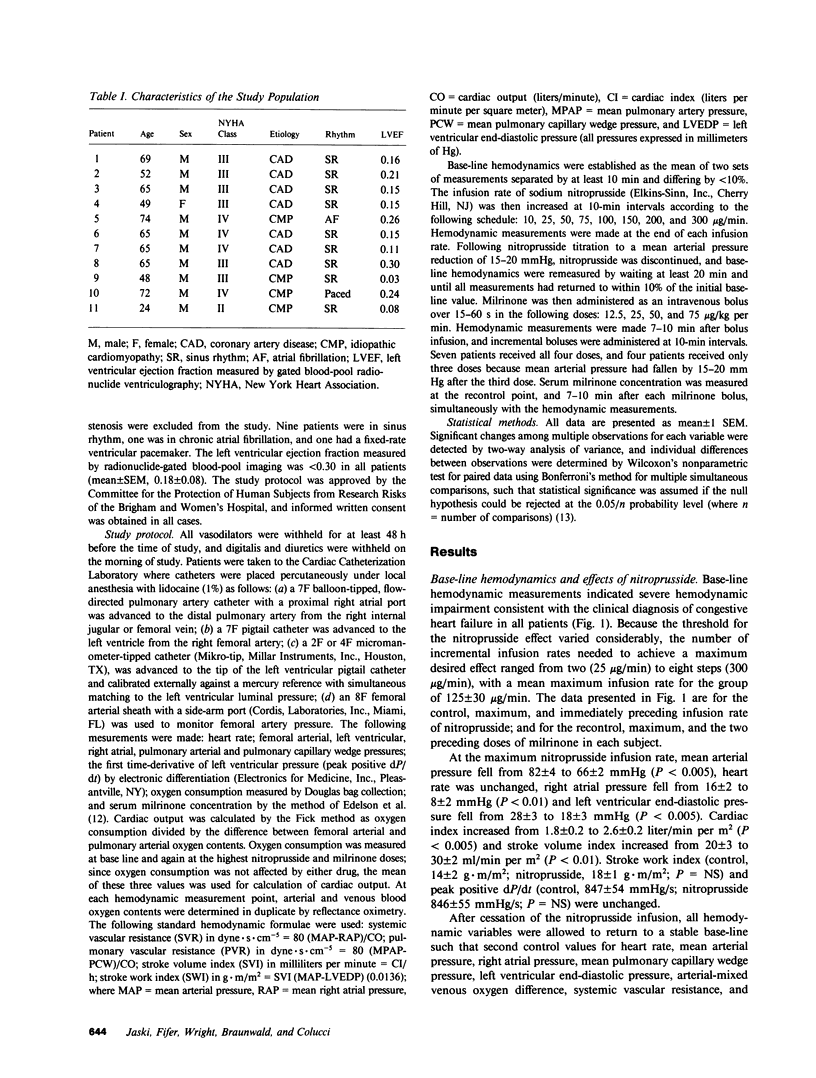
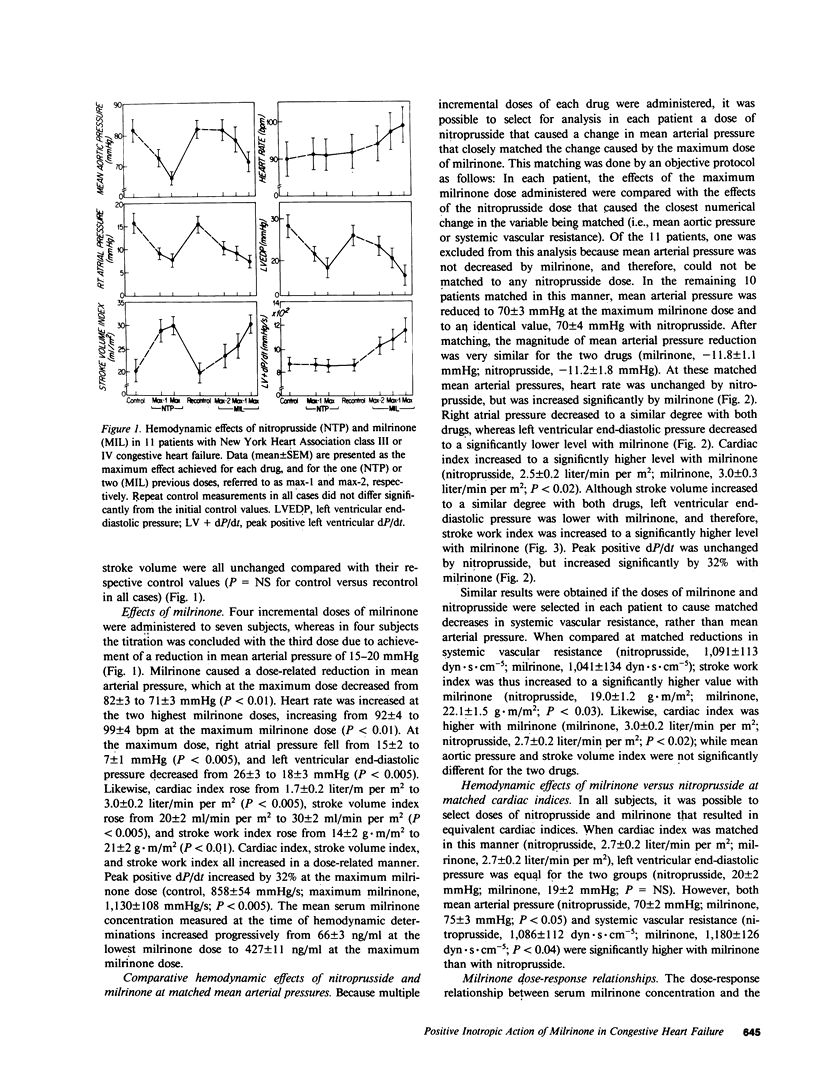
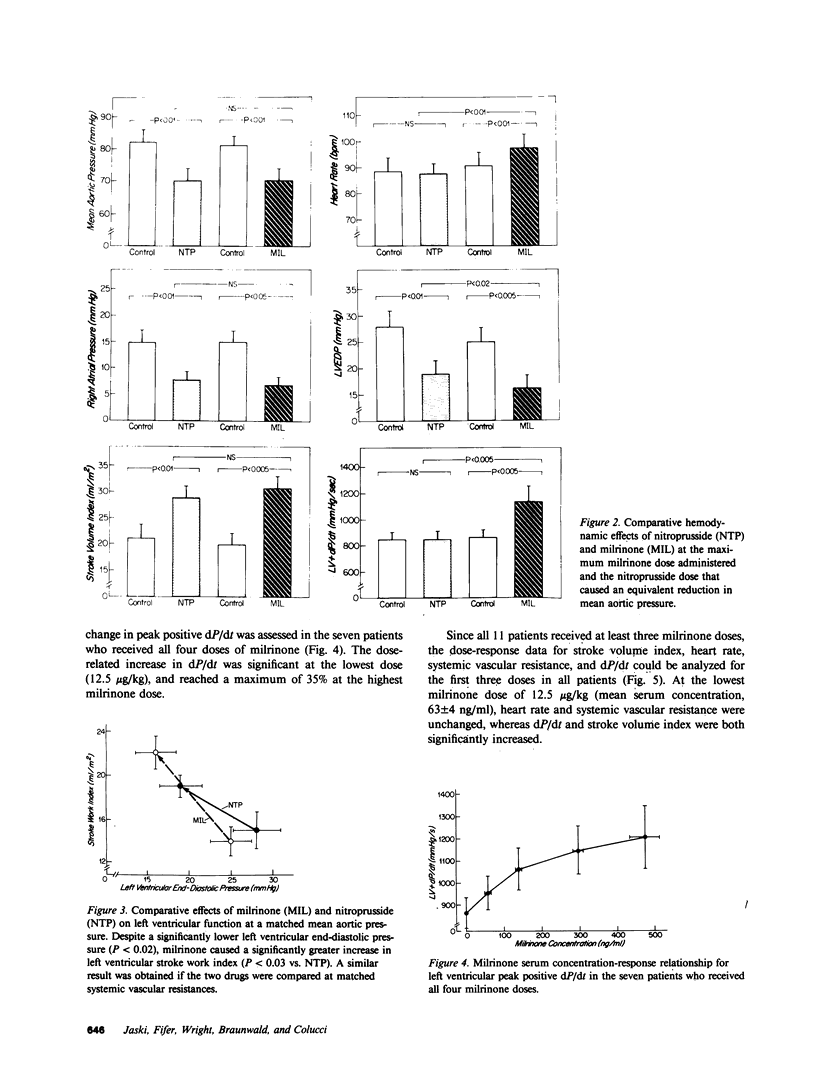
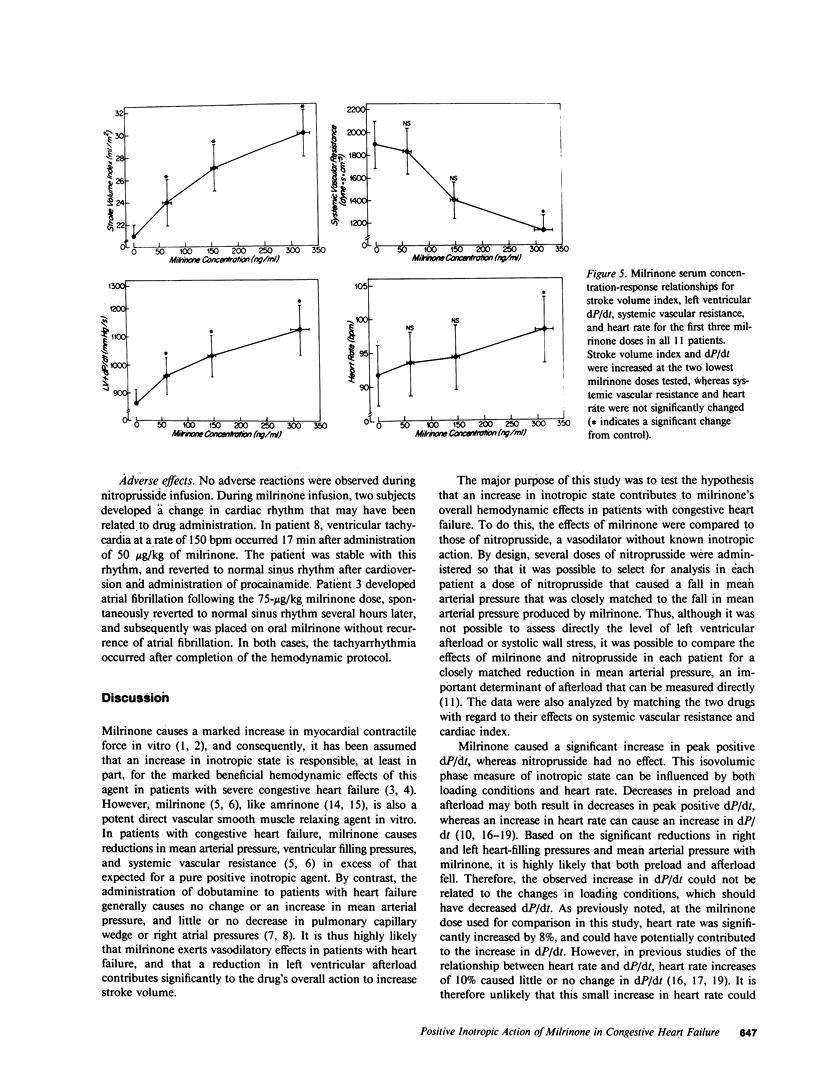
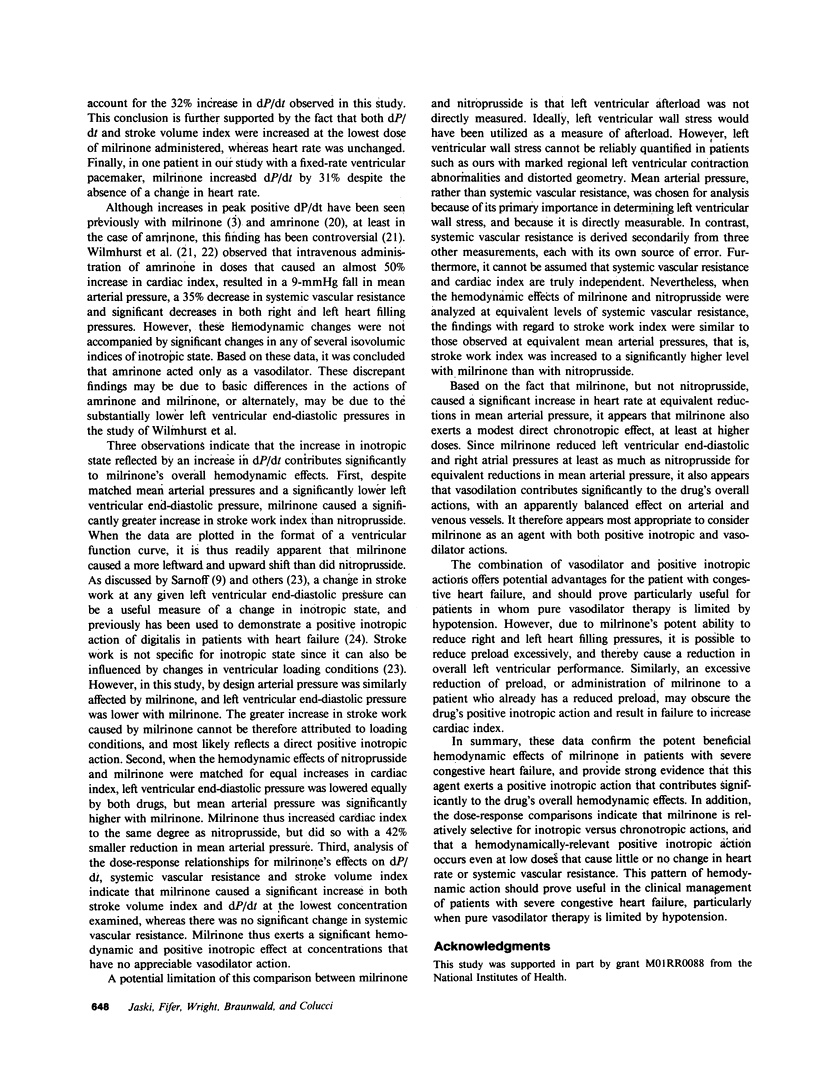
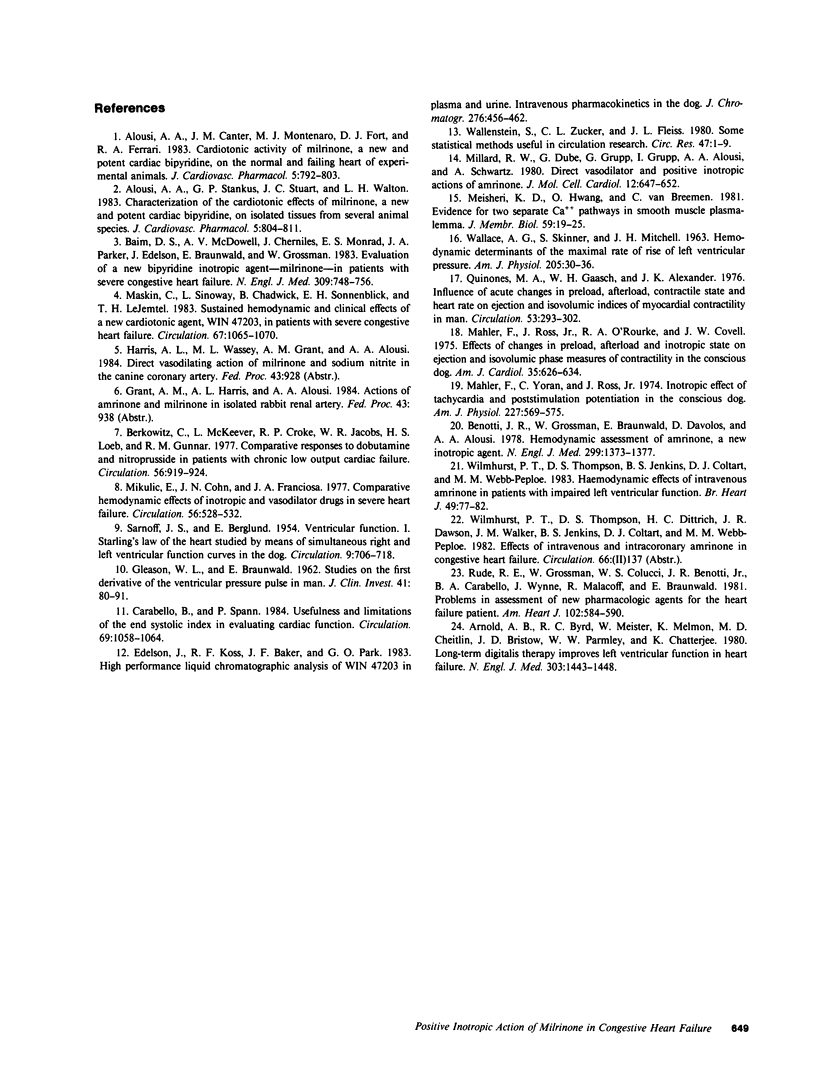
Images in this article
Selected References
These references are in PubMed. This may not be the complete list of references from this article.
- Alousi A. A., Canter J. M., Montenaro M. J., Fort D. J., Ferrari R. A. Cardiotonic activity of milrinone, a new and potent cardiac bipyridine, on the normal and failing heart of experimental animals. J Cardiovasc Pharmacol. 1983 Sep-Oct;5(5):792–803. doi: 10.1097/00005344-198309000-00014. [DOI] [PubMed] [Google Scholar]
- Alousi A. A., Stankus G. P., Stuart J. C., Walton L. H. Characterization of the cardiotonic effects of milrinone, a new and potent cardiac bipyridine, on isolated tissues from several animal species. J Cardiovasc Pharmacol. 1983 Sep-Oct;5(5):804–811. doi: 10.1097/00005344-198309000-00015. [DOI] [PubMed] [Google Scholar]
- Arnold S. B., Byrd R. C., Meister W., Melmon K., Cheitlin M. D., Bristow J. D., Parmley W. W., Chatterjee K. Long-term digitalis therapy improves left ventricular function in heart failure. N Engl J Med. 1980 Dec 18;303(25):1443–1448. doi: 10.1056/NEJM198012183032503. [DOI] [PubMed] [Google Scholar]
- Baim D. S., McDowell A. V., Cherniles J., Monrad E. S., Parker J. A., Edelson J., Braunwald E., Grossman W. Evaluation of a new bipyridine inotropic agent--milrinone--in patients with severe congestive heart failure. N Engl J Med. 1983 Sep 29;309(13):748–756. doi: 10.1056/NEJM198309293091302. [DOI] [PubMed] [Google Scholar]
- Benotti J. R., Grossman W., Braunwald E., Davolos D. D., Alousi A. A. Hemodynamic assessment of amrinone. A new inotropic agent. N Engl J Med. 1978 Dec 21;299(25):1373–1377. doi: 10.1056/NEJM197812212992501. [DOI] [PubMed] [Google Scholar]
- Berkowitz C., McKeever L., Croke R. P., Jacobs W. R., Loeb H. S., Gunnar R. M. Comparative responses to dobutamine and nitroprusside in patients with chronic low output cardiac failure. Circulation. 1977 Dec;56(6):918–924. doi: 10.1161/01.cir.56.6.918. [DOI] [PubMed] [Google Scholar]
- Carabello B. A., Spann J. F. The uses and limitations of end-systolic indexes of left ventricular function. Circulation. 1984 May;69(5):1058–1064. doi: 10.1161/01.cir.69.5.1058. [DOI] [PubMed] [Google Scholar]
- Edelson J., Koss R. F., Baker J. F., Park G. B. High-performance liquid chromatographic analysis of milrinone in plasma and urine. Intravenous pharmacokinetics in the dog. J Chromatogr. 1983 Sep 9;276(2):456–462. doi: 10.1016/s0378-4347(00)85117-8. [DOI] [PubMed] [Google Scholar]
- GLEASON W. L., BRAUNWALD E. Studies on the first derivative of the ventricular pressure pulse in man. J Clin Invest. 1962 Jan;41:80–91. doi: 10.1172/JCI104469. [DOI] [PMC free article] [PubMed] [Google Scholar]
- Mahler F., Ross J., Jr, O'Rourke R. A., Covell J. W. Effects of changes in preload, afterload and inotropic state on ejection and isovolumic phase measures of contractility in the conscious dog. Am J Cardiol. 1975 May;35(5):626–634. doi: 10.1016/0002-9149(75)90048-x. [DOI] [PubMed] [Google Scholar]
- Mahler F., Yoran C., Ross J., Jr Intropic effect of tachycardia and poststimulation potentiation in the conscious dog. Am J Physiol. 1974 Sep;227(3):569–575. doi: 10.1152/ajplegacy.1974.227.3.569. [DOI] [PubMed] [Google Scholar]
- Maskin C. S., Sinoway L., Chadwick B., Sonnenblick E. H., Le Jemtel T. H. Sustained hemodynamic and clinical effects of a new cardiotonic agent, WIN 47203, in patients with severe congestive heart failure. Circulation. 1983 May;67(5):1065–1070. doi: 10.1161/01.cir.67.5.1065. [DOI] [PubMed] [Google Scholar]
- Meisheri K. D., Hwang O., van Breemen C. Evidence for two separated Ca2+ pathways in smooth muscle plasmalemma. J Membr Biol. 1981 Mar 15;59(1):19–25. doi: 10.1007/BF01870817. [DOI] [PubMed] [Google Scholar]
- Mikulic E., Cohn J. N., Franciosa J. A. Comparative hemodynamic effects of inotropic and vasodilator drugs in severe heart failure. Circulation. 1977 Oct;56(4 Pt 1):528–533. doi: 10.1161/01.cir.56.4.528. [DOI] [PubMed] [Google Scholar]
- Millard R. W., Dubé G., Grupp G., Grupp I., Alousi A., Schwartz A. Direct vasodilator and positive inotropic actions of amrinone. J Mol Cell Cardiol. 1980 Jun;12(6):647–652. doi: 10.1016/0022-2828(80)90022-x. [DOI] [PubMed] [Google Scholar]
- Quinones M. A., Gaasch W. H., Alexander J. K. Influence of acute changes in preload, afterload, contractile state and heart rate on ejection and isovolumic indices of myocardial contractility in man. Circulation. 1976 Feb;53(2):293–302. doi: 10.1161/01.cir.53.2.293. [DOI] [PubMed] [Google Scholar]
- Rude R. E., Grossman W., Colucci W. S., Benotti J. R., Carabello B. A., Wynne J., Malacoff R., Braunwald E. Problems in assessment of new pharmacologic agents for the heart failure patient. Am Heart J. 1981 Sep;102(3 Pt 2):584–590. doi: 10.1016/0002-8703(81)90748-1. [DOI] [PubMed] [Google Scholar]
- SARNOFF S. J., BERGLUND E. Ventricular function. I. Starling's law of the heart studied by means of simultaneous right and left ventricular function curves in the dog. Circulation. 1954 May;9(5):706–718. doi: 10.1161/01.cir.9.5.706. [DOI] [PubMed] [Google Scholar]
- WALLACE A. G., SKINNER N. S., Jr, MITCHELL J. H. Hemodynamic determinants of the maximal rate of rise of left ventricular pressure. Am J Physiol. 1963 Jul;205:30–36. doi: 10.1152/ajplegacy.1963.205.1.30. [DOI] [PubMed] [Google Scholar]
- Wallenstein S., Zucker C. L., Fleiss J. L. Some statistical methods useful in circulation research. Circ Res. 1980 Jul;47(1):1–9. doi: 10.1161/01.res.47.1.1. [DOI] [PubMed] [Google Scholar]
- Wilmshurst P. T., Thompson D. S., Jenkins B. S., Coltart D. J., Webb-Peploe M. M. Haemodynamic effects of intravenous amrinone in patients with impaired left ventricular function. Br Heart J. 1983 Jan;49(1):77–82. doi: 10.1136/hrt.49.1.77. [DOI] [PMC free article] [PubMed] [Google Scholar]








